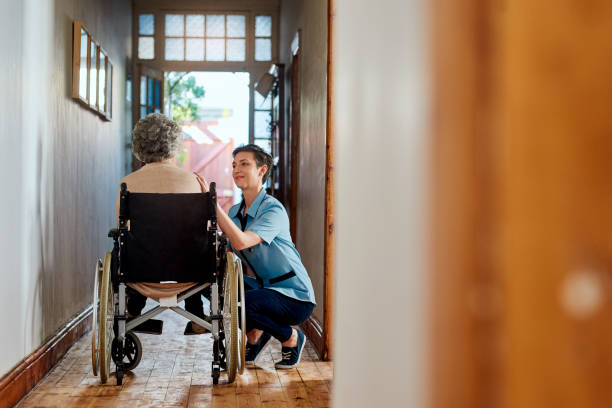In the realm of eldercare, ensuring the safety and comfort of seniors as they navigate their daily routines is paramount. One common task that can pose a challenge is assisting a senior into their wheelchair. This guide aims to provide step-by-step instructions to ensure this process is done safely and comfortably for both the senior and caregiver, minimizing the risk of falls or injury. By adhering to these guidelines, caregivers can offer the essential support seniors need while promoting their autonomy and dignity.
Contents
Preparing for the Transfer
Below are the steps to follow before attempting a transfer:
- Assess the senior’s physical abilities and any potential limitations.
- Make sure the wheelchair is in good working condition, with all brakes engaged.
- Clear a path from the bed or chair to the wheelchair, removing any tripping hazards.
- Place a non-slip mat under both the senior’s feet and the wheelchair’s wheels for added stability.
- Adjust the seat height of the wheelchair to match the seniors’.
Communicating with the seniors throughout this process is essential, ensuring they are comfortable and informed about each step. Encouraging them to participate as much as possible can help maintain their independence and build trust between caregiver and senior.
The Transfer

Shot of a nurse caring for a senior patient in a retirement home
- Position yourself next to the senior’s stronger side. If they have a weaker side, consider starting from that side to help them build strength.
- Place one hand on their shoulder and your other hand under their thigh, close to the knee.
- Instruct the senior to scoot towards you while using their arms for support as much as possible.
- As they do so, assist by lifting them at the hip and pushing gently from their knee to help them slide across.
- Once they are close enough, place your arms around their waist, making sure to keep a firm grip while instructing them to stand up.
- Slowly pivot together towards the wheelchair, making sure not to twist or strain your back.
- Guide the senior down onto the wheelchair seat, ensuring their feet are securely on the footrest.
- Help them adjust their clothing and position themselves comfortably before engaging the brakes.
Safety Considerations
- Always prioritize proper body mechanics to avoid strain or injury.
- If you feel uncertain or uneasy at any point during the transfer, do not hesitate to call for assistance from another caregiver or medical professional.
- If the senior has a history of falls or difficulty with transfers, consider investing in transfer aids such as a gait belt or slide board for added support and ease.
- Avoid rushing and take your time to ensure both you and the senior are comfortable and secure throughout the process.
What Are the Risks?
Assisting a senior into their wheelchair may seem like a straightforward task, but it is essential to approach it with caution and care. Some of the potential risks that can arise during this process include:
- Falls: A lack of support or proper body mechanics can result in falls for either the senior or caregiver.
- Strain or injury: Improper lifting techniques or overexertion can cause physical strain or injury for the caregiver.
- Discomfort or embarrassment for the senior: It is vital to communicate and respect the senior’s autonomy during this process to avoid any discomfort or feelings of embarrassment.
By following these guidelines and considering potential risks, caregivers can ensure a safe and comfortable transfer for both themselves and the seniors they care for. Remember to always approach this task with patience, empathy, and the utmost importance for safety.
Additionally, caregivers should also consider any additional accommodations or modifications that may be needed to make the transfer process easier and safer for all involved. This may include adding grab bars or using a mechanical lift if necessary.
Post-Transfer Care
After successfully transferring a senior into their wheelchair, the caregiver’s responsibilities continue.
- Always double-check that the wheelchair’s brakes are engaged to prevent any unwanted movement.
- Ensure the senior is comfortable and well-positioned, with back support properly adjusted.
- Check for any pressure sores or discomfort caused during the transfer process; these can lead to serious complications if not addressed promptly.
- Keep a close eye on the senior for signs of fatigue or discomfort throughout the day. Adjusting their position or schedule rest periods might be necessary if they show any signs of distress.
- Regularly inspect the wheelchair for maintenance needs. This includes checking the tire pressure, ensuring all parts are functioning correctly, and cleaning the chair to maintain hygiene.
- Encourage the seniors to communicate their needs and discomforts. Open communication can prevent minor issues from escalating into major problems.
Post-transfer care is just as crucial as the transfer itself, and caregivers must be vigilant and responsive to ensure the health and well-being of the senior.
Conclusion
Assisting a senior in their wheelchair may seem like a small task. Still, it requires careful preparation, communication, and attention to safety. By following these guidelines and considering potential risks and accommodations, caregivers can ensure the transfer process is safe and comfortable for both themselves and the seniors they care for. Remember to approach this task with patience, empathy, and the utmost importance for safety at all times.

